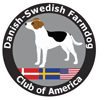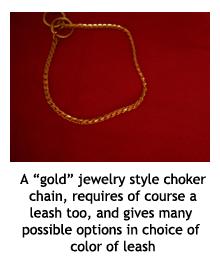Dog Show Preparation
By Helene R. Petersen
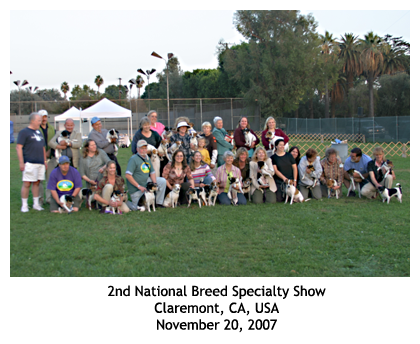
"Dog show? No way!" "I have never been to a dog show, and my dog would go nuts around all the other dogs."
"I have seen it on TV, it is definitely not for us."
Those are the two most common first responses to the suggestion of joining the showing group of the farmdog family. Since I have been along, throughout the past 8 years, the group of people trying to show for the first time has exploded in numbers. We had only 7 Farmdogs at the first show I went to ... and look at us now! Since then, not one, that I know of, have joined, who have shown dogs before. So lots of other recent first-timers are around for support, to ask and get help from, and to understand your concerns really well.
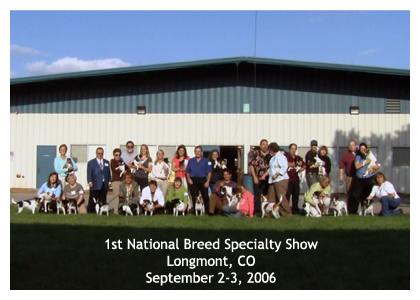 While
seeming as an intimidating idea at first, many have now proven,
that it is not near as challenging as first suspected, and can
testify to you, that it was well worth it, and not all that hard.
While
seeming as an intimidating idea at first, many have now proven,
that it is not near as challenging as first suspected, and can
testify to you, that it was well worth it, and not all that hard.
I remember being at dog shows since I was 5. Every time I think I have seen it all, I learn something new. Because I have volunteered as one of the club's show class instructors at our specialty shows for a few years now, I have a good idea, which items most first timers need to focus on, and which mistakes are the most common, yet easy to correct and deal with.
 And
no panic - we are able to help dogs show just fine, even if they
have never even practiced one single time, just as long as some
of us more experienced "show people" get to work with you and
the dog from approximately a day before the show, and maybe once
or twice again on the show day. It can be done, just come on
out and play, it is such great fun, and so very special, to be
part of tallying up the numbers of Farmdogs all together, at
the same time, in one spot.
And
no panic - we are able to help dogs show just fine, even if they
have never even practiced one single time, just as long as some
of us more experienced "show people" get to work with you and
the dog from approximately a day before the show, and maybe once
or twice again on the show day. It can be done, just come on
out and play, it is such great fun, and so very special, to be
part of tallying up the numbers of Farmdogs all together, at
the same time, in one spot.
Show leads
To show a dog, you need a show lead. There are many, many kinds on the market, and price ranges from just a few $$ to hundreds of $$ for the customized, special hand made kinds. Show leads/collars are often compared to "jewelry", it is finer, lighter, more elegant, and often made out of a more expensive quality of materials, than normal dog "tack". However, show leads and collars are absolutely unsuitable for every-day wear and tear use. Therefore consider limiting the size of the initial investment in purchasing show tack. Unless you know you will be showing one or more dogs on a regular basis for a long time to come.
It is insurmountable to include shopping links here, but If you do a google search on "dog show lead" you will get ample shopping options. It is rather rare to be able to walk into a US pet store and buy a show lead, they are usually not in stock in stores, so be out in good time, and shop online.
Generally show leads come in either an all-in-one type, with various types of collars, or in 2-piece sets with separate collar and leash. Mix and match on the 2 piece items are of course optional, just be aware, that i.e. leather is not always of the exact same color, when produced by 2 different companies, even if both claim to be "black".
For a Farmdog we need a lead not too much longer than approximately 40 inches, or 3 feet, or 1 meter. A show lead is to be held tight, and without too much excess length to have "dangling".
I have included some pictures of some of the different styles in show leads, which I have "collected" over time, being this is my only real "shopping ism". It is more to show the different types, than actual brands or particular items. I have no recollection of where each was purchased, most of them are from vendors' booths at dog shows abroad.
Conformation Classes
I can warmly recommend taking a conformation class. This would entirely prepare you and your dog for what to expect, and help your practice tremendously. Most all-round training facilities, which offer various classes in i.e. obedience, rally O, agility etc., also offer conformation classes. Go with no expectation, other than it will likely be the most boring class you have ever been to. But it really is great learning and practice for both you and your dog.
Myths
Myths about, that if a dog is scared and uncomfortable on a vet's table, then it will be difficult to put on a show table, are just that, myths. None of my dogs willingly get on a vet's table, they do it, because they have to, but they start instantly to blow their coat (shed) like crazy at the vet's, due to nerves. But they will all stand on a show table, no nerves, and therefore I am certain they have never even as much as compared the two.
That is the beauty of this breed, they are so smart, they easily recognize the difference between the vet clinic and the shiny, slick aluminum table, alone with you and a vet in an enclosed little room, and then the scenario at i.e. an outdoors show with grass, open air, a skid proof show table, lots of other dogs and people around it, and no smell of disease and death.
Practice
Teach your dog "stand" command
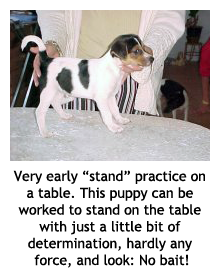
When your dog is standing anyway, put a piece of soft treat in front of it's nose, say "stand" (a hand signal may be chosen also, if desired), and the dog will in 99.9% of the cases, sit instantly.
Don't let the dog nibble of the soft treat yet, but say "no, Stand", and "pull" the dog up in standing position with the treat (it'll typically just follow your hand), if need be, hold a stretched finger in the groin, to keep it from sitting too fast. The instant it stands, let it nibble of the soft treat for as long as it stays standing, as soon as it sits down again (probably when you remove your finger), start over. In no time, the dog will understand, that this is no longer "sit" practice, and will try to figure out, what is expected. You need the treat to be completely level with the dog's nose, and not above the head (which is what it has learned for sit). You can also, if the dog sits, put a finger in the groin, while it's sitting, and push up a bit, while "pulling" with the treat, most dogs will stand instantly, treat (let nibble, while standing) right away and praise, say the command "stand" and praise many, many repeated times, while the dog is standing.
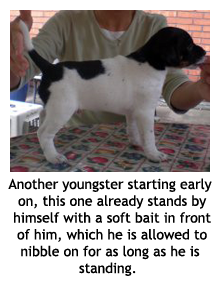
Keep the practice this way, until you feel, the dog knows, that this is a new thing, that it has to think about. Then add time. For now, you've treated for stand, even if it's only a split-second. Now you use the command and treat still in front of nose, say "stand", and when the dog stands, you try to add distance between the treat and the nose. Do a quick "hand away from nose, say: "Stand", and hand back, treat, praise". If the dog sits, while you quickly remove your hand, say "no" and try again. And as the dog improves, add difficulty. You want it to get to where you can be standing upright in front of, or next to the dog, giving the stand command (this is where a hand command from the beginning may become helpful).
When you first begin "stand" practice, you might not want to stand up next to the dog yourself, your dog is little, and the "hovering above" when you bend over it with the treat, can be intimidating, and cause it to not want to stand, but rather want to sit, lay down, or move away from you. So ...when you first start "stand" practice ...consider doing so with the dog standing on top of a table ...
Never put a hand under the chest or belly of your dog to make it stand. It destroys the natural position of a stand, and will mess up everything on the dog's top line, under line, angulation etc. It will never get a natural stand with a hand under the belly or chest. The finger in the groin is really good, and grabbing the dog from behind by the butt between the back thighs is even more commonly used and works very, very well. But not a hand under the belly.
Practice for the dog to be walking next to you on your left in a counter clockwise circle, and also walk it on your left in a straight line, and do "about turns". Teach the dog to take the stand command, while you move around a little more, a few extra steps in one or the other direction and/or stand still next to it. All of the above can be practiced in your living room, on your bed (you walking next to the dog on the bed, for the length of the bed, and come to a stand on the edge), in the back yard etc.
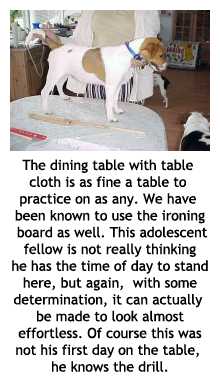 Practice stand command on the ground too, but also on a table.
Use any table with a surface, that is not slick (the work bench
in the garage perhaps?), or put a "matt" on the kitchen
table or dining table for the dog to stand on. Practice that
you help the dog stand on a "table" (anything that
resembles a table), while someone else "examines" the
dog - just touching it basically on the back, the sides, the
legs, checking teeth, etc.
Practice stand command on the ground too, but also on a table.
Use any table with a surface, that is not slick (the work bench
in the garage perhaps?), or put a "matt" on the kitchen
table or dining table for the dog to stand on. Practice that
you help the dog stand on a "table" (anything that
resembles a table), while someone else "examines" the
dog - just touching it basically on the back, the sides, the
legs, checking teeth, etc.
Use tables in different places ...the pick-nick table at the park, a high water well cover/man hole somewhere, a bench, etc.
Hint: If you have taught your dog obedience heel and it is trained to sit, when you stop, then add a new dimension to that. Make 2 different ways for yourself to stop. One for obedience heeling, prompting for a sit at the stop, where you I.e. stop with your feet close together side by side, and your side turned to the dog, and another kind of stop for shows, prompting for a stand at the stop, where you I.e. stop with one foot just a small "step" in front of the other, and turn your body towards your dog, instead of keeping your side turned to it. This will help your dog tell there is a difference between what it has to do at the 2 kinds of stops, and when to do what. Of course your verbal command "stand" will help enforce it too, but this extra body language will save your dog some confusion, and you some frustration, when you go back to the obedience practice.
Check teeth
A judge has to be able to check you dog's bite, while the dog is on the table. It doesn't necessarily need to stand on the table, when the bite is being checked, it can be sitting. But it has to allow it because, if it pulls back, most judges will excuse you from the ring immediately. Puppies and the younger age group classes are often allowed some "slack" and given a second chance in this department, but don't expect it.
So check your dog's teeth every day, many times a day, while it is on the table. With a young and first time showing dog in particular, do it when the chance of success is greatest, in other words, when it seems tired, or is resting. At least in the beginning, so it gets used to you doing this, which it will, when it becomes part of every day routines. Make sure to have treats in your pocket, ready to dispense the instant the dog lets you see the teeth. Grab with one hand around the muzzle, and lift the lips with the other hand, both upper and lower lip, to see the front teeth and the side teeth. The dog is not supposed to open it's mouth while you look at the teeth, but to keep the bite closed, hence the hand gently around the muzzle. Be firm and determined, without being rough and forceful. You don't want to intimidate the dog to let you see the bite, but you want to let it know, that it WILL let you do this, and it's ok. Lots of treats and praise. Then, whenever possible, have others check your dog's teeth as well, the more different people, the better. Get the dog used to, that any time you wish to, it's really a lot of fun, for it to let you see it's teeth, because the treats are really delicious, when it does it. Do not fight looking at the teeth, it has to be done, when the dog will allow you to do it without extended fight. Again, allow the dog to get used to it, by giving treat and praise even for hardly any time at all, and slowly increase the time, as the dog understands, what you want.
 Table
practice is going to be like a big 'party' ...fun, up-beat, exciting,
special treats to look forward to. That is what you make it.
Table
practice is going to be like a big 'party' ...fun, up-beat, exciting,
special treats to look forward to. That is what you make it.
I have had dogs myself, which would under no circumstances be
on a table, even with practice as above. Group pressure comes
in handy at that time.
I have watched dogs like that take a spot in the "line" to willingly
get up onto my kitchen table, and get dried chicken or beef liver
...because if that is where it is served to the others, who
will let me put them on the table). Then even the most stubborn
of stubborn is going to crave getting on my kitchen table. First
time up, I let them get up there once, give one super treat,
and then I put them back down on the floor. And then I pick up
the other dogs one after the other and keep feeding them on the
table. But I make the difficult one wait and wait to get back
up for more. They will try to jump, leap, and beg the best they
know, to get up onto any table I present them to after that.
A little help from a friend with one or more easy "table dogs",
if you have trouble, is worth considering to get. Using group
pressure as described, and of course increasing the time on the
table, as the dog gets more comfortable with the idea of being
there.
Walk on a leash at a trot, and come to a stand.
Practice anywhere anytime, to walk with the dog on a leash at a "brisk" (to the dog) pace. If it canters, slow it down to trot again, and slow yourself down too - find the pace, that fits your dog's gait best, it's supposed to trot only, not slow motion, but "kicking along" well. Lots of praise and lots of treats for trotting along next to you. Add the "stand" command, when coming to a stop. When it sits, help it back to the stand, by moving a step or 2 forward (now you're beyond having to grab it by the groin, a simple step forward, will do the job for you, and remind the dog, what stand means, if need be, show the treat in front of the nose, rather than up high (making it want to sit) as a reminder. Give the command, while the dog is back up on it's feet. Praise and treat every time it does things right.
You're done - ready to go in the ring. This can be obtained with a young puppy, and several little sessions every day, in about 2 weeks.
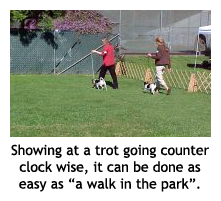
When you are in the show ring, you are allowed to have treats, give treats (just don't give the dog a treat right as the judge is about to check teeth on the table of course), you may also use "discrete" toys, whatever makes your dog walk with you, while looking up with attention away from the "nose in the grass habit". You want trot head high, tail high.
I usually always have a treat in my free hand, and carry the
arm stretched above and slightly in front of them, while walking,
if they insist on having the head down to smell the ground. Utilize
that you are allowed to do this, especially with a young dog,
so the entire show experience seems relaxed and fun to the dog,
and not like some formal obedience class session. The extent
of the use of these aids is limited to being ok, just as long
as it does not interfere with other people's showing of their
dogs. So loud squeekie toys and tennis balls may be a bit too
bold. As you can well imagine, it can indeed interrupt an entire
ring of Farmdogs of course. It is also recommended
to use soft treats, because hard treats crumble, when broken
and/or chewed. 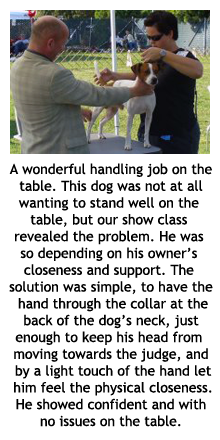 Both
other exhibitors and you yourself will have a hard time getting
dogs to prance with the heads up, if you, or someone else, have
dumped treat crumbs in the grass.
Both
other exhibitors and you yourself will have a hard time getting
dogs to prance with the heads up, if you, or someone else, have
dumped treat crumbs in the grass.
And remember, the judge is not going to judge you, he/she is going to judge your dog. No reason to be nervous period, your dog looks like your dog looks, no matter what you do, you can't change a thing. Just help it to look happy (which FDs generally do by nature anyway), that's really the most important.
As for the concerns about a dog "going nuts" over all the other dogs at a show, it is actually more common that they don't. The confusion and "magnitude" of a dog show, most often has it's (beneficial) humbling effect on an otherwise excitable dog. Again, a class with other dogs showing is beneficial, because your dog will learn to walk with you with other dogs ahead and behind it, as is normal in the ring. But you will be surprised how well your dog will be able to focus on you. Because of the general confusion at a show, with people and dogs, endless smells and sounds to stimulate, you may all of a sudden become the most valuable thing for your dog to support to.
"Attire"
A question which is often asked is, "what should I wear?"
There are no requirements in any rule books of appropriate
attire for dog shows. But a good rule of thumb is, that a dog
show is more formal, than other dog sport events. Yet it is not
a flashy fashion show, the judge is supposed to see your dog
before you. In respect and recognition of the formal scenario,
we therefore usually avoid wearing i.e. blue jeans. Some women
prefer to wear a skirt or a dress, others wear slack type pants,
caprices, or shorts. On real hot days, we have had male exhibitors
wearing shorts. It is ok to some, others don't feel comfortable,
when some other male exhibitors (such as professional handlers,
which we do encounter in other breeds) arrive in dark suits and
newly shined dress shoes. Personal preference is really the most
important, you need to feel comfortable, and not be too dressed
up in the best "whites", because you will have dogs jumping up
on you all day, with grassy, perhaps even muddy feet, etc.
You are welcome to browse through the pictures on my website
under "shows" to see what we all have been wearing through the
years of showing the Farmdogs: http://www.farmdogs.net/showHWC07.html
Dog "attire"
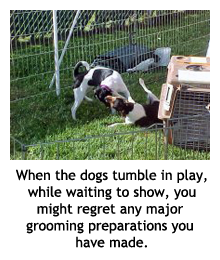 Don't go and pay for an expensive grooming, "dog perfume",
or the likes. Our dogs are a natural, sturdy type of dog, not
a little "foo-foo", and
we take great pride in that. I am guilty of having shown my dogs
without having given them as much as a bath or a brushing for
months prior ...it was a tight rushed thing, but no-one noticed.
I did trim their nails the night before, if the nails are long,
consider getting them trimmed, or trim them yourself.
Don't go and pay for an expensive grooming, "dog perfume",
or the likes. Our dogs are a natural, sturdy type of dog, not
a little "foo-foo", and
we take great pride in that. I am guilty of having shown my dogs
without having given them as much as a bath or a brushing for
months prior ...it was a tight rushed thing, but no-one noticed.
I did trim their nails the night before, if the nails are long,
consider getting them trimmed, or trim them yourself.
Generally just a bath, and a quick brushing to remove the most "wild" of the loose hair, is plenty sufficient. Next thing you know, they will tumble in play with the others, while waiting to show, or lay down in the grass to rest, and you will feel any preparation was a waste.
So don't make a great big deal out of grooming your farmdog for a dog show. As you know, they are self-cleaning, and we (seriously) can for the most part rely on that feature to work perfectly fine for us.
Lastly:
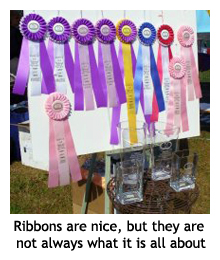 Ribbons
are nice, but they are not always what it is all about. No matter
the results of a show, I feel I have done my very best, if my
dogs behaved and walked on the leash, stood on the table for
examination, and did their best in what I trained them to do.
I cannot change the way they look and are put together, which
is what they are judged by. Only very few dogs win. I therefore
measure my personal success in the part I can make a difference
in, namely their behavior in the show ring, and on the table.
If they did their best, I have done well enough!!!
Ribbons
are nice, but they are not always what it is all about. No matter
the results of a show, I feel I have done my very best, if my
dogs behaved and walked on the leash, stood on the table for
examination, and did their best in what I trained them to do.
I cannot change the way they look and are put together, which
is what they are judged by. Only very few dogs win. I therefore
measure my personal success in the part I can make a difference
in, namely their behavior in the show ring, and on the table.
If they did their best, I have done well enough!!!
See you at ring side.
Helene
